5 Great Reasons to Grow Buttonbush (Cephalanthus occidentalis)
The first thing you will notice about Buttonbush (Cephalanthus occidentalis) is its showy blooms. Its ball shaped flowers that resemble little white pom-poms are beautiful and unique.
Upon closer inspection, you’ll see that the fragrant flowers are alive with pollinators! If you’re looking to add a large shrub to your native plant gardens that will benefit insect pollinators and wildlife, then Buttonbush is a fun one to try.
Want to attract more butterflies and bees to your yard? Be sure to download my FREE Pollinator Nectar Plants PDF. Take this handy one-pager to the nursery to get the native plants that pollinators LOVE!
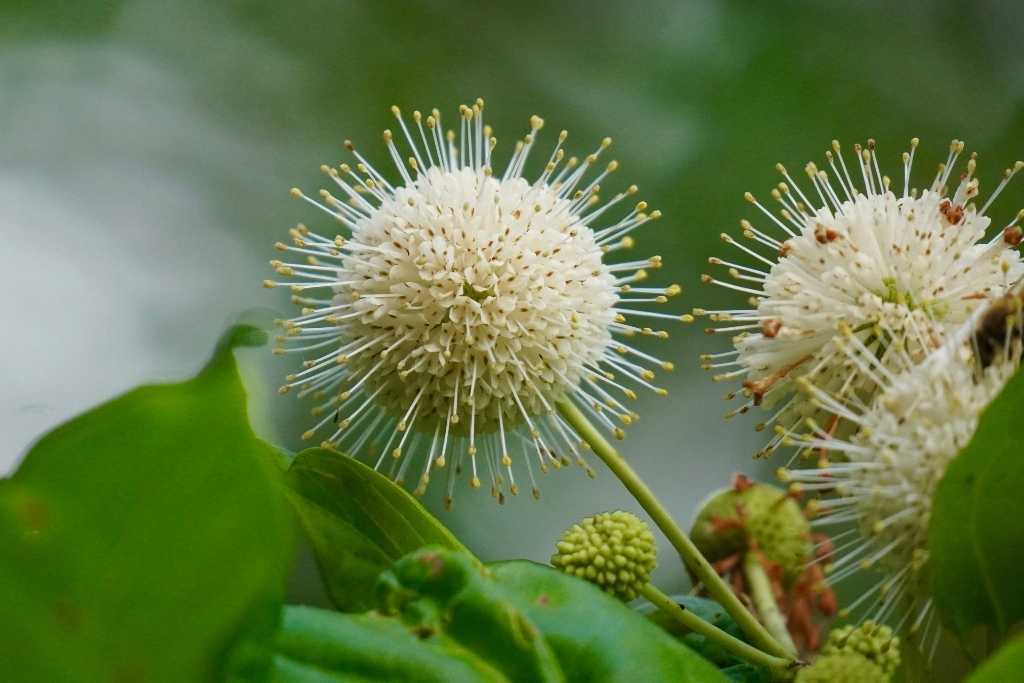
This post contains affiliate links. See our full disclosure.
5 Reasons to Grow Buttonbush
1. It is an awesome nectar plant
The fragrant white flowers that appear on the plant from June to August (early summer to late summer) are irresistible to native bumble bees, honey bees, butterflies, and other pollinators.
You will often see a variety of insect species enjoying the same round clusters of flowers. It’s fun to watch! To get the most flowers on your Buttonbush plant it in full sun with supplemental water.
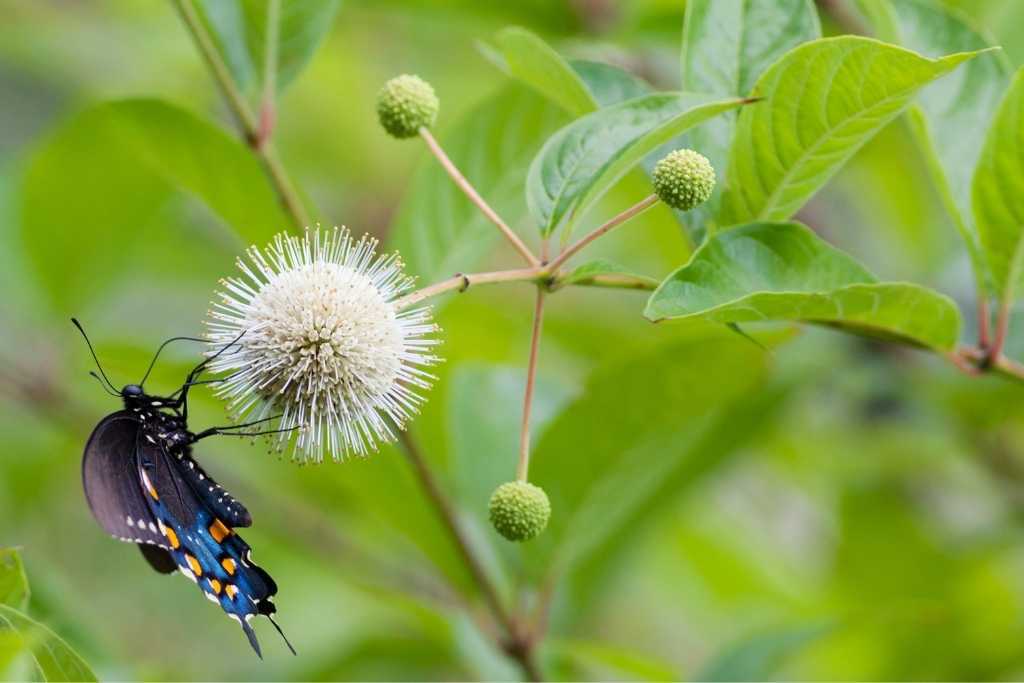
2. It provides food for wildlife
Starting in the early fall, the flowers transition to reddish brown nutlets that resemble balls or buttons. These fruits provide food for wildlife, especially water birds such as wood ducks, over the winter. According to Native Texas Plants, they attract more than 25 species of waterfowl!
If your property is close to a body of water, this would be a great plant to provide food for birds visiting the water.
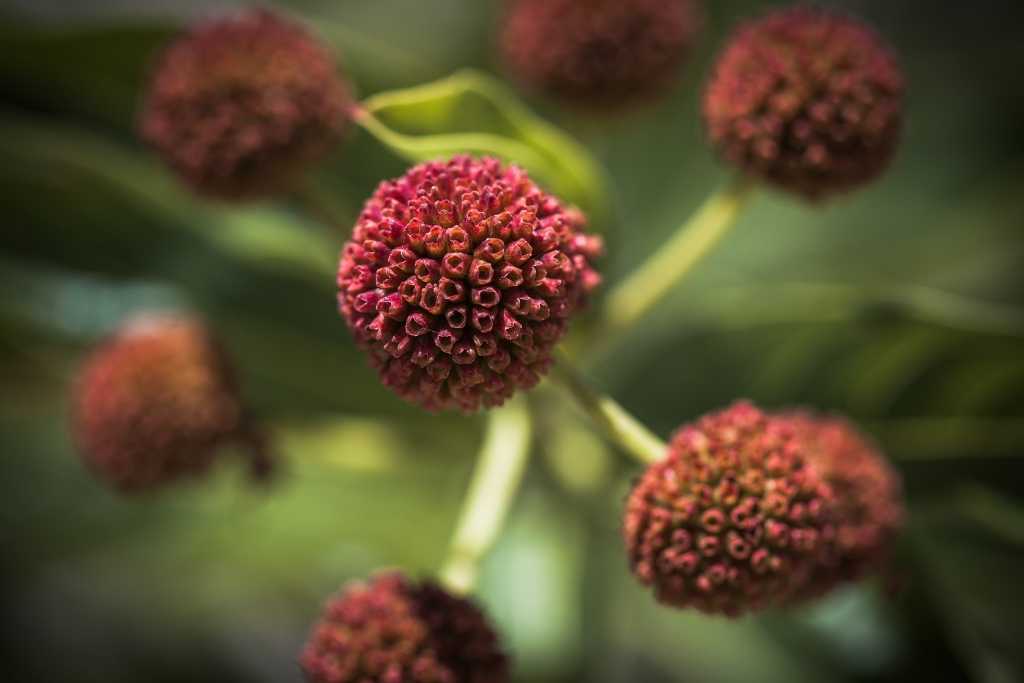
3. It is a moth host plant
In addition to having nectar plants available to feed adult butterflies and moths, it is equally important to grow host plants. These are the specific plants that butterflies and moths will lay their eggs on because their caterpillars can eat them.
Buttonbush is a host plant for two gorgeous Sphinx moths – the Hydrangea Sphinx and the Titan Sphinx.
4. It is a great choice for a rain garden or erosion control
Buttonbush is not picky about the soil type. It likes wet areas and can even handle flood conditions, so wet soils and poor drainage is ok. It is a versatile native shrub for a rain garden or to prevent erosion.
In natural areas, you’ll often see buttonbush shrubs growing along lowland areas, wet thickets, rivers, and stream banks.
5. It makes a presence in your garden
If you are looking for unique native plants to add to your garden, then Buttonbush tree is a great choice, as long as you have plenty of room. This deciduous shrub grows 6-9 feet tall and wide. It is a great statement plant to mix in with smaller native perennials.
The large woody shrub thrives in full sun but can handle part shade. In addition to its summer blooms, it can provide some fall color to your garden through its deep reddish brown fruits and yellow foliage.
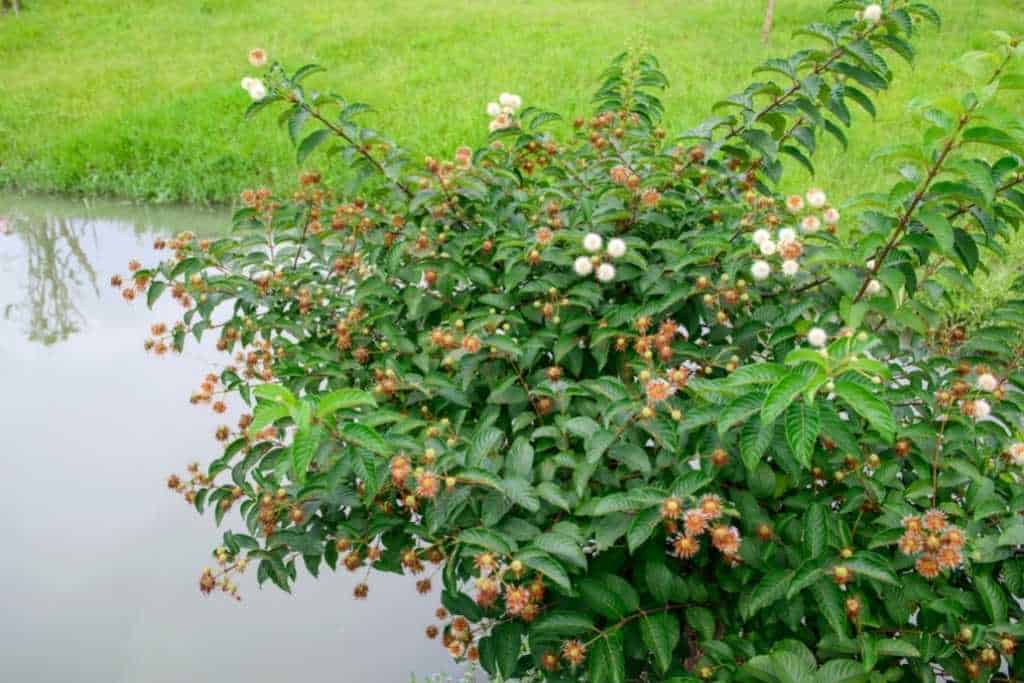
Download the Free PDF: Native Nectar Plants
Want all the pollinators in your yard? I created a handy one-page PDF for you to print and take along with you to the plant nursery. It includes a thumbnail photo of each plant along with both its common and scientific name, shade requirements, and other helpful growing info. Get it here:
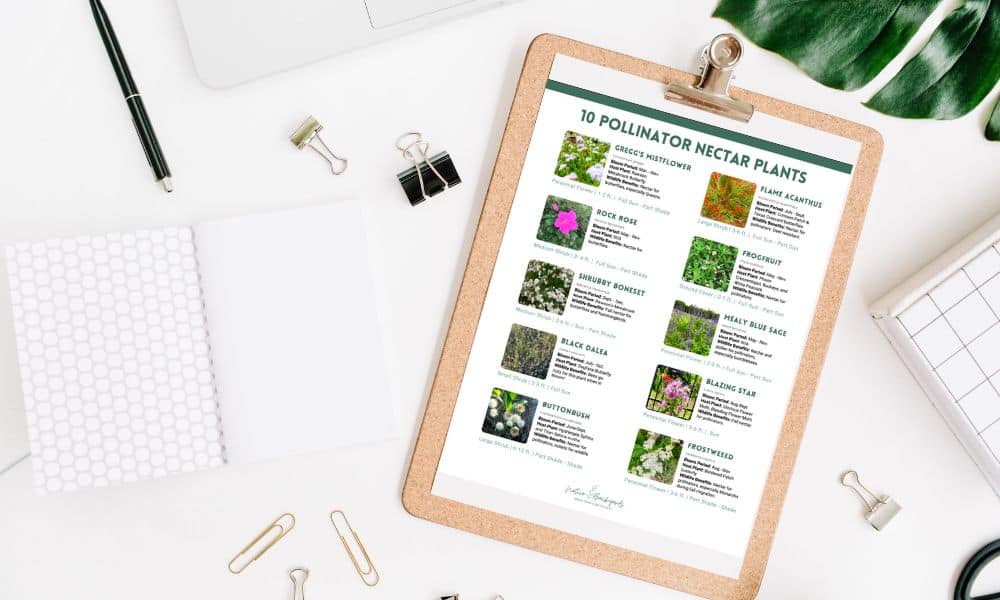
What does Buttonbush look like?
Buttonbush is a multi-stemmed shrub that typically grows 6-9 feet tall. However it can sometimes reach the size of a small tree, over 15 feet tall. It has some of the most unique flowers of any shrub.
The spherical flower heads are 1-2 inches large surrounded by pistils. They resemble golf balls or pom-poms. The plant has glossy green leaves, and in the fall and winter will have reddish brown nutlets / fruit.

Where is the Buttonbush plant native to?
Button bush has a broad native range throughout North America. In the U.S. it is native in the Southern and Eastern United States. It is also native to parts of Canada and Mexico. Here is a list of states where it is native to:
- Alabama
- Arizona
- Arkansas
- California
- Connecticut
- Delaware
- Florida
- Georgia
- Illinois
- Iowa
- Indiana
- Kansas
- Kentucky
- Louisiana
- Maine
- Maryland
- Massachusetts
- Michigan
- Minnesota
- Missouri
- Mississippi
- Nebraska
- New Hampshire
- New Jersey
- New York
- North Carolina
- Ohio
- Oklahoma
- Pennsylvania
- Rhode Island
- South Carolina
- Tennessee
- Texas
- Virginia
- Vermont
- Wisconsin
- West Virginia
What is the scientific name for Buttonbush?
This plant’s scientific name is Cephalanthus occidentalis. It is in the genus Cephalanthus which combines the Greek words for “head” and “flower”. The species name “occidentalis” refers to the West.
What are the other common names for Buttonbush?
A plant has only one scientific name. However, a single plant can have many common names. In addition to being called Buttonbush, it also goes by Common Buttonbush, Button Willow, and Honey Bells.
How do you grow Buttonbush?
Buttonbush can grow in full sun to partial sun / partial shade. It will bloom throughout the summer in full sun, and on and off in shade.
It may require supplemental watering in full sun or periods of drought, as it likes moist soil. I have seen a Buttonbush thriving in full sun with drip irrigation. This wetland shrub can even handle living in some standing water.
Buttonbush tends to grow into an irregular form and can spread by suckers. You can prune new growth as needed to create a more rounded habit and limit sideways shoots. Cutting back the limbs significantly in late winter / early spring will also help keep its size in check.
You can collect buttonbush seeds for propagation, or you can propagate the plant by soft root cuttings.
What is Buttonbush a great native alternative for?
If you have a non-native Vitex (Butterflybush) in you yard, consider replacing it with Common Buttonbush. This native will attract just as many pollinators and has a similar growth habit to Vitex, without being invasive. Vitex has shown to be invasive in dry creek beds in Texas.
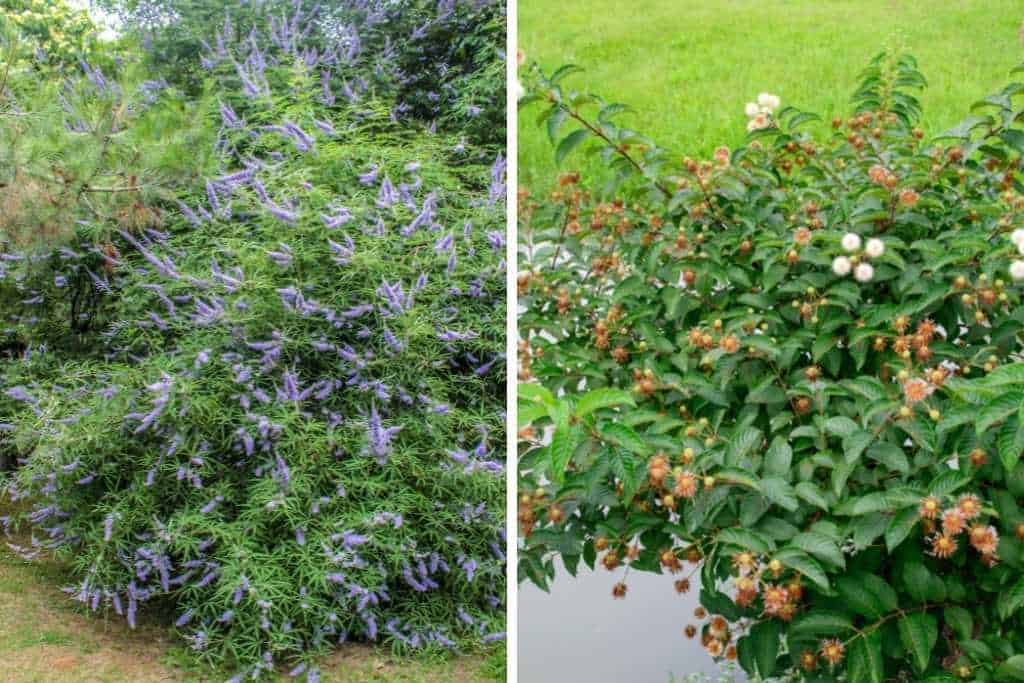
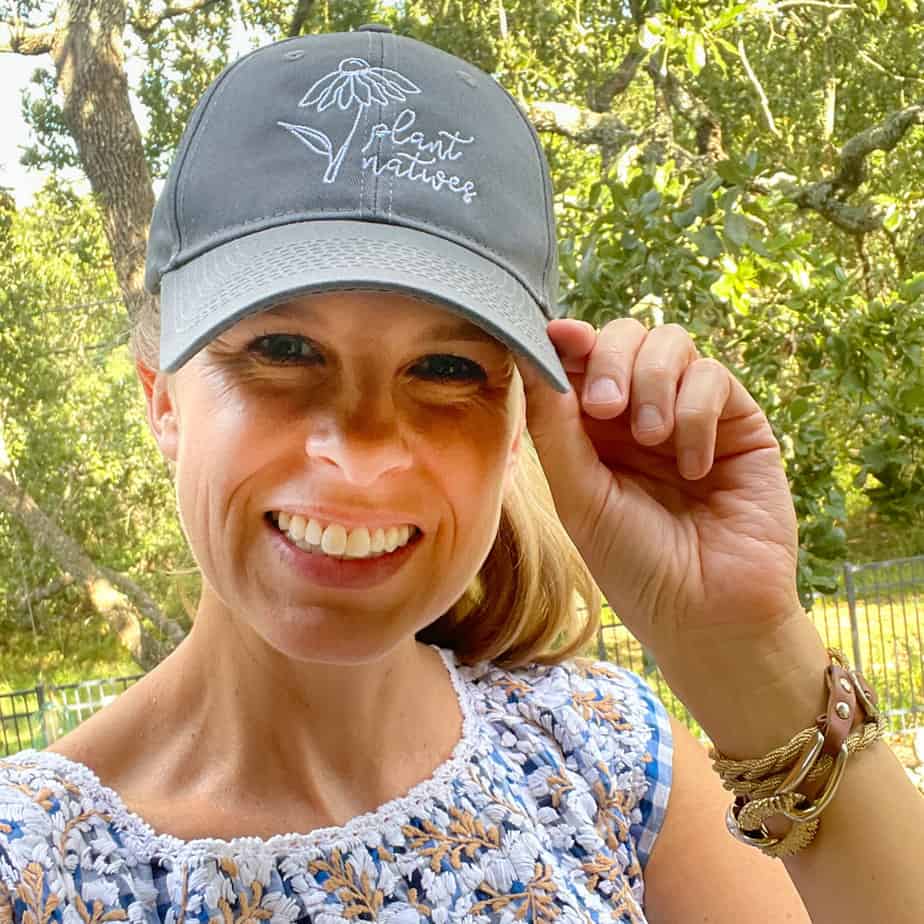
Welcome to Native Backyards! I’m Haeley from San Antonio, Texas, and I want to help you grow more native plants.
I have seen firsthand how the right plants can bring your yard to life with butterflies, bees, and birds. I’ve transformed my yard with Texas natives and I’m excited to share what I’ve learned with you.
Join my newsletter here! – each week I’ll send you helpful tips to make your native plant garden a reality!
Want to learn more about me and my garden? Check out my About page!
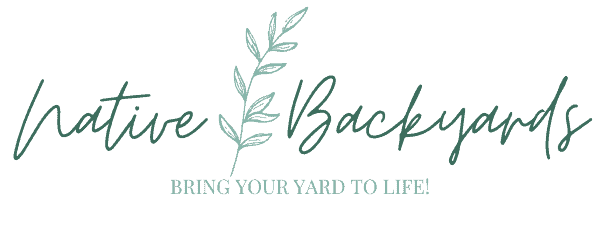
May I use your photos for my paintings 🖼? I will give you 😊 proper photo credits on the back of the canvas. I am an aspiring artist 🎨. Thank you in advance.
Hi Susan, you are welcome to paint these photos for personal use.
I’ve grown these plants for more than 10 years and they are even easier to propagate than you’ve stated. I’ve taken stem cuttings 3 – 4′ long and shoved them into the ground and the majority have rooted. For erosion control few plants work better.
We have experienced two years in a row here in Texas where we have had hard freezes (10-15 degrees for multiple days). Will the buttonbush survive a hard freeze?
Hi John, Buttonbush should be completely fine with a hard freeze. It can be found growing as far north as Canada. Here is some info: https://hgic.clemson.edu/factsheet/common-buttonbush/
Are their medicinal properties for the blooms, leaves etc?
Hi Lyn, according to the Ladybird Johnson Wildflower Center database (wildflower.org): “The poisonous foliage of this abundant and widespread species is unpalatable to livestock. The bitter bark has served in home remedies, but its medicinal value is doubtful.”